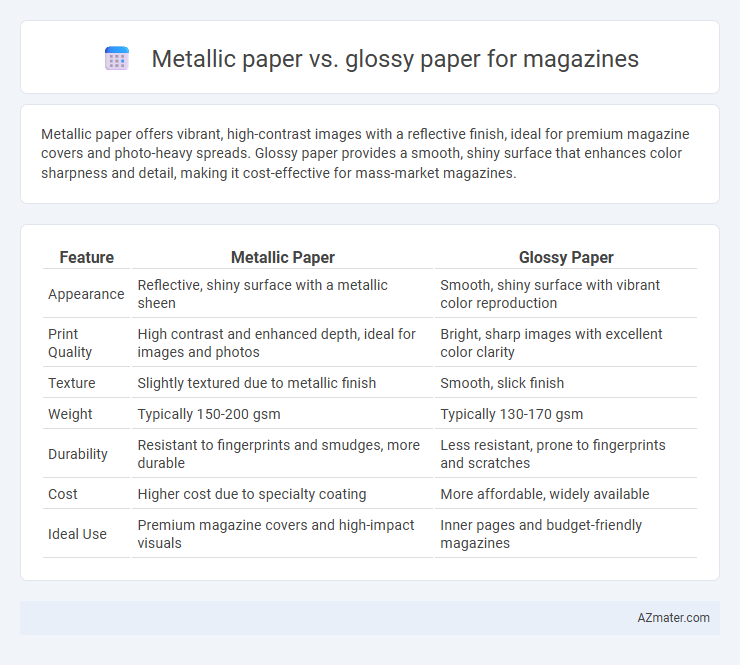Metallic paper offers vibrant, high-contrast images with a reflective finish, ideal for premium magazine covers and photo-heavy spreads. Glossy paper provides a smooth, shiny surface that enhances color sharpness and detail, making it cost-effective for mass-market magazines.
Table of Comparison
| Feature | Metallic Paper | Glossy Paper |
|---|---|---|
| Appearance | Reflective, shiny surface with a metallic sheen | Smooth, shiny surface with vibrant color reproduction |
| Print Quality | High contrast and enhanced depth, ideal for images and photos | Bright, sharp images with excellent color clarity |
| Texture | Slightly textured due to metallic finish | Smooth, slick finish |
| Weight | Typically 150-200 gsm | Typically 130-170 gsm |
| Durability | Resistant to fingerprints and smudges, more durable | Less resistant, prone to fingerprints and scratches |
| Cost | Higher cost due to specialty coating | More affordable, widely available |
| Ideal Use | Premium magazine covers and high-impact visuals | Inner pages and budget-friendly magazines |
Overview: Metallic Paper vs Glossy Paper
Metallic paper features a reflective, shimmering surface that enhances images with a vibrant, eye-catching finish, ideal for magazines aiming for a high-impact visual appeal. Glossy paper offers a smooth, shiny surface that produces sharp, bright colors and deep contrasts, making it suitable for magazines with detailed photography and rich color reproduction. Both papers provide high-quality print results, but metallic paper emphasizes brilliance and depth, while glossy paper prioritizes clarity and color accuracy.
Print Quality: Visual Impact and Color Vibrancy
Metallic paper delivers a striking print quality with enhanced visual impact due to its pearlescent finish, which intensifies color vibrancy and adds depth to images, making magazine covers and pages stand out. Glossy paper offers a smooth, reflective surface that enhances sharpness and brightness, producing rich, vivid colors but lacks the unique shimmer that metallic paper provides. For magazines aiming to captivate readers through dynamic visuals and vibrant hues, metallic paper often outperforms glossy paper by elevating overall aesthetic appeal.
Texture and Finish Differences
Metallic paper features a lustrous, reflective surface with a slightly textured finish that enhances color depth and creates a shimmering effect, making images appear more vibrant and dynamic. Glossy paper, in contrast, has a smooth, mirror-like surface that delivers sharp, high-contrast visuals with brilliant color saturation but lacks the subtle tactile texture found in metallic variants. The choice between metallic and glossy paper significantly influences the tactile experience and visual impact of magazine prints, with metallic offering a more premium, textured feel and glossy providing a sleek, polished finish.
Durability and Longevity
Metallic paper offers superior durability compared to glossy paper due to its thicker coating and resistance to scratches, making it ideal for magazines that require long-lasting, vibrant visuals. Glossy paper, while providing a smooth finish and high color saturation, tends to be more prone to fingerprints and wear over time. For magazines aiming for extended longevity and enhanced protection against handling, metallic paper is the preferred choice.
Suitability for Magazine Photography
Metallic paper enhances magazine photography by providing high color saturation and deep contrast, making images appear more vibrant and detailed, especially for fashion and product photography. Glossy paper offers a smooth, shiny finish that reflects light evenly, highlighting sharpness and fine details while maintaining a natural color palette suitable for diverse photographic styles. Both papers amplify visual appeal, but metallic paper excels in dynamic, high-impact images, whereas glossy paper supports versatility and consistent photo reproduction.
Cost Comparison: Metallic vs Glossy
Metallic paper generally costs 15-30% more than glossy paper due to its unique reflective coating and specialized production process. Glossy paper remains the more budget-friendly option, with standard printing costs averaging $0.10 to $0.25 per sheet, compared to metallic paper, which can range from $0.18 to $0.40 per sheet depending on quality and quantity. The higher price of metallic paper can be justified by its premium appearance and visual impact in high-end magazine print runs.
Readability and Eye Comfort
Metallic paper enhances magazine visuals with vibrant colors and high contrast, improving readability by making images and text pop, but its reflective surface can cause glare, potentially straining the eyes. Glossy paper offers a smooth finish that provides sharp text and images with less glare, resulting in better eye comfort during extended reading sessions. For magazines prioritizing readability and eye comfort, glossy paper often proves more effective, while metallic paper suits high-impact visual appeal where occasional glare is acceptable.
Environmental Impact and Sustainability
Metallic paper contains a thin layer of aluminum coating, making it less recyclable and more energy-intensive to produce compared to glossy paper, which typically uses standard coatings that are easier to recycle. Glossy paper tends to have a lower environmental footprint due to simpler manufacturing processes and better compatibility with recycling systems. For sustainable magazine production, selecting glossy paper supports reduced carbon emissions and waste generation, aligning with eco-friendly printing practices.
Popular Magazine Uses for Each Paper Type
Metallic paper is favored by popular magazines like National Geographic and Vogue for its vibrant colors and high contrast, enhancing photo-rich spreads and luxury branding. Glossy paper is commonly used by fashion and lifestyle magazines such as Cosmopolitan and Elle, offering a smooth, shiny finish that highlights detailed images and text clarity. Each paper type caters to specific aesthetic and tactile preferences, with metallic paper excelling in dramatic visual impact and glossy paper providing widespread appeal for editorial content.
Choosing the Right Paper for Your Magazine
Metallic paper offers vibrant, high-contrast visuals with a unique shimmer, making it ideal for magazines emphasizing luxury and vivid photography. Glossy paper provides a smooth finish with sharp color reproduction, perfect for mainstream magazines focused on clarity and brightness. Selecting between metallic and glossy paper depends on your magazine's aesthetic goals and budget, balancing visual impact against cost-effectiveness.

Infographic: Metallic paper vs Glossy paper for Magazine
 azmater.com
azmater.com